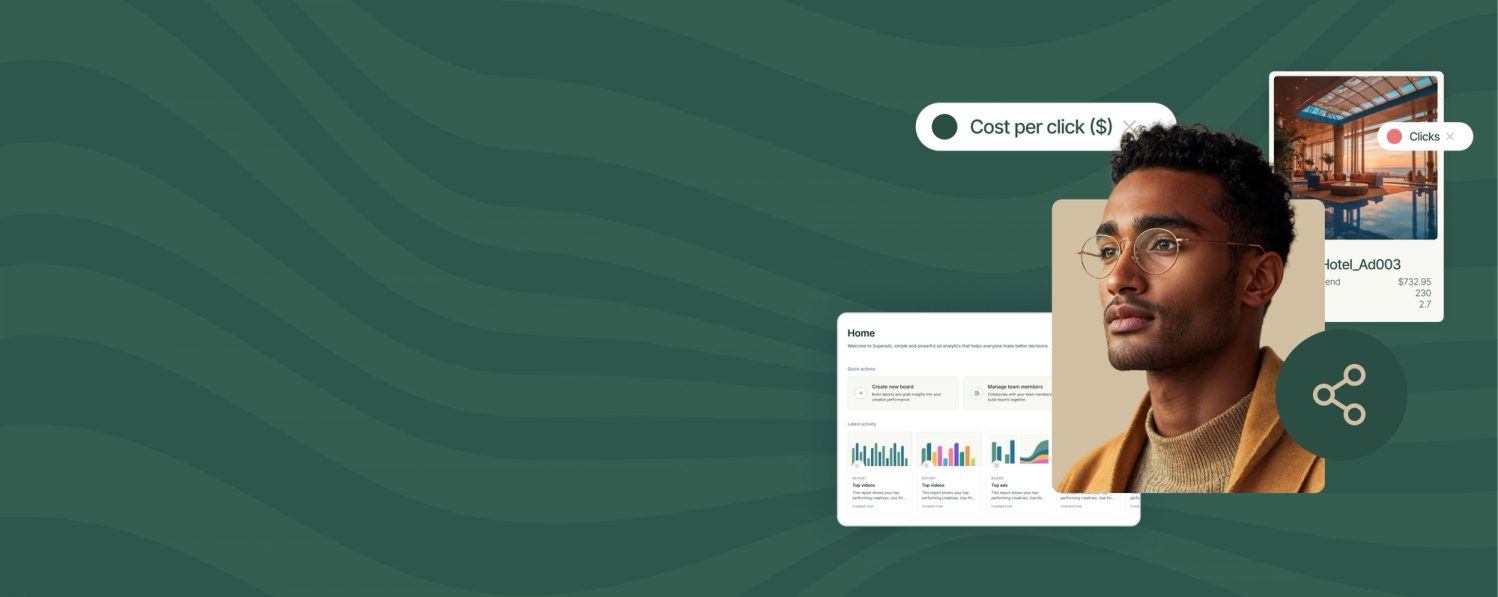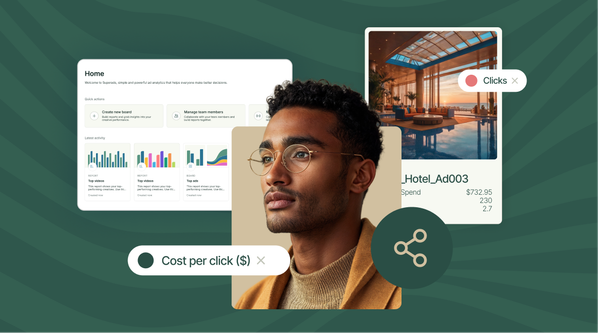Why Data-Driven Design is Key to High-Performing Campaigns

A data-driven approach to design eliminates guesswork and helps you focus on producing creative that meets user needs and business goals. In fact, using data to shape your creative choices unleashes a whole new level of potential for your brand.
Using data-driven insights to craft compelling creative that resonates with your target market is the secret sauce that boosts business outcomes. A design that focuses only on aesthetics often misses the mark, failing to connect with users or drive meaningful results.
Conversely, the data-driven design process uses quantitative and qualitative data, enabling designers to create functional creative work that captivates audiences and drives conversions.
Data-driven marketing is no longer just an option—it's essential for businesses of all sizes.
Not sure where to begin? This article examines the nuts and bolts of data-driven design, its powerful benefits and the best practices for incorporating data in your design process, including insights from Kirsten van Rooyen, Superside’s Associate Director of Marketing Strategy. Let’s get started. 👇
What Is Data-Driven Design?
Data-driven design is where creativity meets analytics, using insights to craft visuals that don’t just look good but drive results–something we like to call creative performance.
Organizations that use data to drive their decisions are 23 times more likely to attract new customers, nine times more likely to keep customers, and 19 times more likely to be profitable. Unsurprisingly, many big companies are implementing data-driven decisions in their marketing efforts.
A data-driven approach collects data from sources like Google Analytics, usability testing, heatmaps and user feedback. It uses practical insights instead of subjective opinions to inform design.
Unlike a traditional approach to design that often relies on gut instinct and the personal views of UX designers, a data-driven design process embraces informed strategizing. Think data analysis using qualitative and quantitative methods.
Quantitative data tells you what is happening (or not happening)—it’s numerical data—while qualitative data tells you why it’s happening and usually includes feelings, opinions or observations.
Qualitative data can provide valuable insights into user motivation and intent. It’s often collected through user interviews, competitor analysis and focus groups.
Main elements of data-driven design
So, what exactly is data-driven design made of? What should you look at to assess if your design truly leans on data? As Kirsten says, there’s a lot to consider when it comes to the essential elements of data-driven design.
When creating designs for high-performing campaigns, I believe that understanding the human stories behind the data is most impactful, and combining them with data is key.

- Analytics: Analytics tools like Google Analytics offer insights into user behavior through metrics such as page views, bounce rates and session duration. Analyzing this data helps you identify patterns and understand content engagement.
- Customer and audience insights: Gathering insights from user interviews, surveys and feedback reveals your audience’s needs, preferences and pain points. This qualitative data helps you design more relevant solutions and improve the user experience.
- A/B and multivariate testing: A/B testing compares two design versions to determine which performs better based on metrics like click-through rates (CTRs) and conversions. You can also conduct multivariate testing to evaluate several changes simultaneously—such as headlines, images, buttons or colors—and observe how these combinations influence user behavior.
- Heatmaps: A heatmap tool visually shows user interactions, highlighting where people click, scroll and spend time. This type of data helps you understand user behavior, identify areas of interest, and highlight improvements for user experiences.
Data is your marketing superpower, but don’t get bogged down with the details. Good data-driven marketing combines analytics and creativity in equal measure.
While audience behavior metrics like demographics and engagement rates provide a valuable framework and give you an idea of who you are reaching and if the work is impactful or resonant for them, it’s the deeper insights into people’s emotions, motivations, and needs that truly drive effective design.

(PS: If you need support, Superside’s team of project managers and creative experts will help you make strategic decisions based on data-driven strategies for long-term marketing success.)
Why Data-Backed Outperforms Aesthetics-Only
With a data-driven approach, you can:
1. Make more informed decisions. Using qualitative data to guide your design choices helps your decision-making process. When you make data-backed creative decisions, it’s easier to agree on where to place the CTA button or what color to use.
2. Improve user experience. Qualitative data provides insights into user preferences and challenges, helping to create designs that align with user needs. It allows you to evaluate design effectiveness by monitoring user interactions, satisfaction and conversions, enabling continuous improvements to the user journey and the human aspect of design.
By connecting with the real human frustrations, motivations, and solutions behind the numbers, we can create content that resonates on a personal level. It’s about reaching out to someone in a way that feels authentic and meaningful.

3. Access measurable results. Unlike traditional methods, every aspect of a campaign can be tracked and analyzed in data-driven design, enabling you to evaluate effectiveness. This is beneficial for future campaigns.
4. Create personalized and relevant campaigns. Data-driven design helps you create customized content that resonates with your audience and increases conversions. By analyzing data from user interactions, you can identify effective content, colors and layouts. Personalized campaigns tend to lead to higher engagement.
Once this creative core is cracked, you can then optimize the numbers by looking at how much time someone spends with the content or a brand, what messages resonate best, and what visuals make them click more. This helps identify which design elements not only attract attention but also drive desired actions, allowing you to double down on what’s working and scale and test formats and placements.

5. Avoid assumptions. In a data-driven design process, decisions and actions are based on evidence and insights from analyzing data. Relying only on intuition or personal opinions can lead to poor creative results.
6. Scale up–fast. Analyzing data provides insights into user interactions, enabling scalable and consistent user experiences across platforms and devices. In contrast, a design-focused only on aesthetics may not be consistent or flexible across different platforms.
Not sure where to start? Superside specializes in improving creative performance for our customers. We can show you how to use data to design compelling creative that drives conversions, which you can also support with Superads.
6 Major Benefits of Data-Driven Design for High-Performing Campaigns
On average, companies that make data-driven decisions are 5% more productive and 6% more profitable than their competitors.
Using data effectively can lead to better business results through, as Kirsten shows us:
1. Better engagement
Data-driven design can increase engagement by enabling designers to understand what motivates users. Designs based on accurate data better meet user needs, leading to meaningful interactions that drive engagement and conversions.
By analyzing data on how users interact with content, designs can be optimized to keep users engaged longer.

2. Higher conversion rates
You can improve conversion rates by finding the parts of the user journey that cause problems or lead to drop-offs. Once you identify what isn't working, you can improve the experience by simplifying processes or providing personalized recommendations.
Data-driven design focuses on elements proven to encourage user action, leading to increased conversion rates. For example, adjusting a call-to-action button based on data insights could boost conversions for a very low-effort design investment.

3. Better efficiency in the design process
A data-driven process can streamline the design process as design teams have access to valuable insights from the get-go. With a solid foundation, they can make informed decisions, reducing the need for extensive revisions later.
Decisions are based on empirical evidence rather than subjective opinions, reducing the risk associated with design choices.

4. Optimized content and visuals
Data helps improve design elements like images and text. Using qualitative data to guide your design choices enables you to create relevant, compelling and personalized CTAs that connect with your audience and encourage them to take action.
Real-time data allows for quick adjustments in response to user behavior changes, making campaigns more agile and effective.

5. Continuous optimization
Using real-time quantitative data, designers can quickly identify what works and adjust creative based on user behavior and performance metrics.
For example, when Virgin America launched the first-ever responsive airline website in 2014, and A/B tested it against the old version, the results were impressive: A 14% increase in conversion rates, 20% fewer support calls, and customers booked twice as fast.
6. Clear ROI measurement
Measuring your return on investment is easier when your design decisions are backed by quantitative data. You can use metrics like conversion rates, engagement and sales to see how design helps meet business goals.
Focusing on data allows for more efficient use of resources by investing in design elements that deliver the best results, thereby improving return on investment.

How Superside Focuses on Creative Performance for Campaign Success
At Superside, we integrate quantitative data into every aspect of the creative process to ensure all our campaigns look good and exceed expectations, outperforming benchmarks and key performance indicators (KPIs).
At Superside, we ensure our designs are optimized for performance by deeply integrating data analytics into every stage of the creative process. We start by analyzing quantitative data such as click-through rates, conversion metrics, and engagement statistics from previous campaigns.

As early adopters of the technology, we’re crushing the AI game. We have a ton of experience under our belts and know how to harness AI to elevate design and drive better customer engagement.
We use AI to create mockups and color palettes for design variations, freeing designers to focus on creating engaging, user-friendly designs. We also harness AI to analyze user data and design trends to ensure the best possible user experience.
For example, we might examine how a particular color scheme influenced a 15% increase in click-through rates or how certain imagery led to a 20% boost in engagement time. We utilize A/B testing extensively to compare different design elements—like headlines, visuals and call-to-action buttons—to see which versions perform better statistically.

Our data-driven approach includes a comprehensive framework for measuring creativity as well as A/B testing and performance tracking to improve creative output for our customers.
To further streamline the process, we bridge the gap between marketing and creative teams for effective creative outcomes.
This approach ensures that our creative work resonates on a personal level while delivering measurable results, such as increased conversion rates or higher customer retention.

Examples of data-driven designs developed by Superside
Let’s take a look at how Superside approaches data-driven design for our enterprise customers.
Case Study 1: PointCard
The challenge: Fintech company PointCard wanted to differentiate itself in a competitive financial market with a bold look and feel.
The solution: PointCard needed a partner who could follow its brand guidelines, which included a clear visual style and custom design. So, it partnered with Superside as an extension of its design team.
The results: By conducting an ongoing “test and learn” approach and swiftly adjusting strategies based on performance data, Superside created hundreds of creative assets that successfully balanced brand consistency with innovation.
As a result, PointCard gained an impressive 240% increase in CTR and a 275% increase in conversion rates (CVR).
The takeaway: Using data in the design processes, Superside rapidly produced exceptional creative assets and new concepts, surpassing PointCard’s growth expectations.
Case Study 2: Packt
The challenge: Since 2004, publishing company Packt has faced branding issues due to outdated guidelines, which have led to inconsistencies in its digital presence and book covers.
The solution: Packt teamed up with Superside to create a new set of guidelines. Through this collaboration, Packt made data-driven decisions, enhancing its customer engagement.
The results: Superside created a polished set of brand guidelines that refreshed the brand and provided new, captivating ways to express itself, reinforcing its authority in the industry.
The takeaway: By gathering user data and integrating it into the brand refresh, Superside helped Packt improve its brand consistency and visual identity, making it more appealing to its audience.
Top 6 Best Practices To Measure Any Creative
If you’re keen to reap rewards similar to those Superside helped PointCard and Packt achieve, you must adopt a data-driven approach.
Follow these five tips:
1. Set clear goals and key performance indicators (KPIs)
First, set specific goals and KPIs for the design. What do you want to achieve? Increase user engagement, boost conversions or improve click-through rates?
Define what success looks like using specific, measurable KPIs such as conversion rates, click-through rates or engagement time. And stick with them–it's easy to start to dig deep into the data but pick the things you want to see moving in the right direction and look at those- only dig in if you need to learn more.

2. Analyze analytics and user data
Use web analytics to track site visits, duration and page engagement. Check social media insights for post performance, including engagement rates and audience demographics.
Gather customer feedback from surveys or reviews to understand what users like or dislike about your product or service. This helps identify their preferences and challenges, inspiring designs that meet their needs.
3. Testing and iterating
It’s time to start testing. With A/B testing, you create two versions of a design—like a social media post or a webpage—and determine which one performs better. Use the results to guide the rollout for the rest of your campaign.
Implement A/B and multivariate testing to experiment with different design elements and measure their impact on performance metrics. Test small on a key platform and then scale the things that are successful.

4. Collaborating across teams
Everyone on the team—data scientists, designers and marketers—must work together. Communicating and sharing insights helps you make better design decisions, which ultimately helps you reach your campaign goals.
Encourage collaboration between data analysts, strategists, designers, and marketers to ensure data insights effectively inform design decisions.

5. Measuring and adjusting
Check the performance of your creative work regularly. Review the collected data and look at metrics like engagement and click rates to see what works and what doesn't.
If a design doesn’t meet your expectations, make small changes to improve it. You can adjust colors, revise the messaging or try different layouts to improve results.
Regularly review performance data to make iterative improvements. For instance, if data shows a 10% drop in engagement after a design change, be prepared to adjust accordingly and quickly.

Partner With Superside for Potent, Data-Driven Campaign Success
Data-driven design is vital for creating high-performing campaigns that go beyond aesthetics. It facilitates informed decisions based on real user behavior and preferences, resulting in more effective outcomes. You can look forward to improved engagement, higher conversion rates and a refined user experience.
At Superside, we use both data and exceptional design to help our customers succeed. Our data-driven approach can also keep your campaigns fresh, up-to-date and hyper-focused on measurable success.
Nail your next creative campaign—schedule a call with us.
Meet Roger, a content marketer driven by his love for online search, digital marketing, and performance marketing. When he's not immersed in the latest updates on Google, AI and social media, you'll find him passionately crafting strategies to simplify online searches for people, sparing them the frustration of navigating through endless pages. As a marketer, Roger Match has turned into the perfect match for Superside, helping us showcase our purpose, objectives and essence to the world.
Kirsten is the Associate Director of Marketing Strategy at Superside. She has a demonstrated history of working in the marketing and advertising industry, having led digital, media and social strategy at several agencies. Drawing on her digital savvy and passion for video, Kirsten has developed high-performing video marketing strategies for many of Superside's customers, including Masterclass, Zapier and Clari. You can connect with her on LinkedIn here.
You may also like these

7 top creative support solutions for teams and enterprises
There’s no denying that today’s marketing and creative teams are under more stress than ever. To deliver high-performing, top-quality assets at scale, many teams are getting fewer resources, smaller budgets and tighter deadlines.As an ever-increasing number of brands compete for audience attention, the demand for compelling content is getting higher—and essential for creative teams to meet.It’s no surprise then that in-house marketing and creative teams are turning to advanced creative support solutions to help enhance efficiency, streamline workflows and optimize production processes.From AI-powered design to cloud-based collaboration software and outsourced creative services, these solutions transform how teams work, allowing them to produce more assets faster without compromising quality.Our best advice to teams and enterprises on how to get this right? Make Superside your creative team’s creative team and free up your team to do their best work.
How to find creative partner agencies to boost 2025 strategy
Are your internal creatives battling to keep up as the demand for authentic, trustworthy content grows? For many brands, outsourcing creative makes sound financial sense. Plus, partnering with an experienced creative services team can bring fresh ideas and impressive scalability.80% of customers say that the experience a company provides is just as important as its products or services, meaning that driving great customer experiences is essential in 2025. Once again, creative partnerships pay dividends, as many creative agencies go well beyond KPIs to drive genuine cultural impact and build trust.Unlike traditional agencies, creative partner agencies also typically act as an extension of your team. Work with Superside, for example, and our talented designers will become your creative team’s creative team.
The 15 best SaaS website design examples & services for 2025
First impressions count. With attention spans shrinking, SaaS companies must make a strong initial impact with their services.A website is often the first contact with potential customers, and good design is crucial for converting visitors into leads and enhancing a company's credibility.Website design significantly impacts user experience: 94% of first impressions are design-related, and 38% of users leave a site if it looks unattractive.Eighty-eight percent of those users are unlikely to return after a bad experience. Since 59% of Google users only click on one search result, effective SEO optimization is essential, too.Responsive design can increase conversion rates by 11%, while mobile optimization can boost it by 40%. Overall, effective web design significantly enhances customer experience and can lead to up to 400% improvement in conversion rates.















